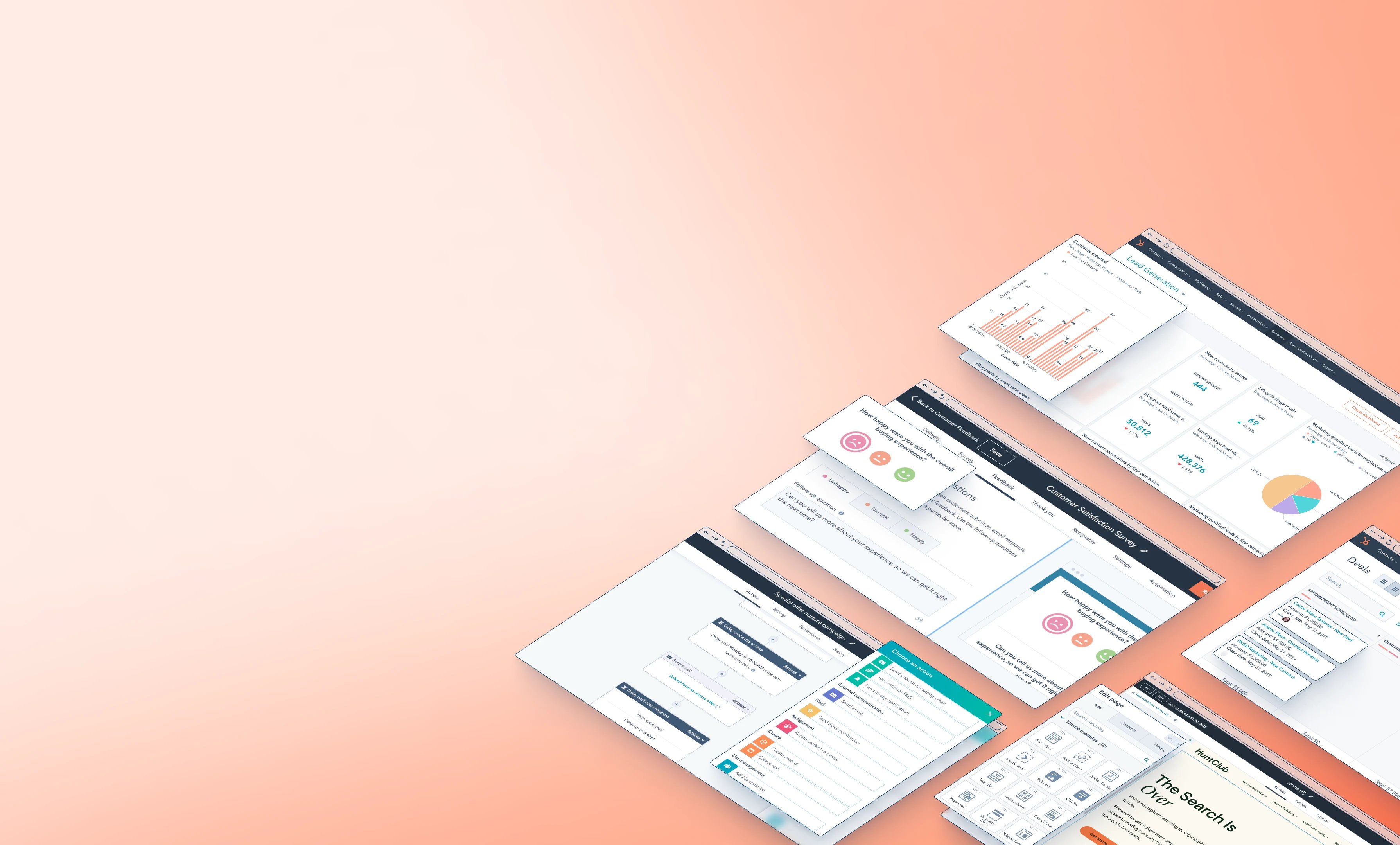
What's Covered?
Experts

VP of Growth

CCO
the inbound methodology
There’s good news for companies that want that for their potential customers—it’s called the inbound methodology.
With inbound, customers are at the center of the process, and go through the Marketing, Sales and Service phases.
Each phase is meant to further inform your lead, turn them into a customer and then into a promoter. If you’re going to go all in on inbound, there’s one CRM, marketing and sales software we recommend: HubSpot.
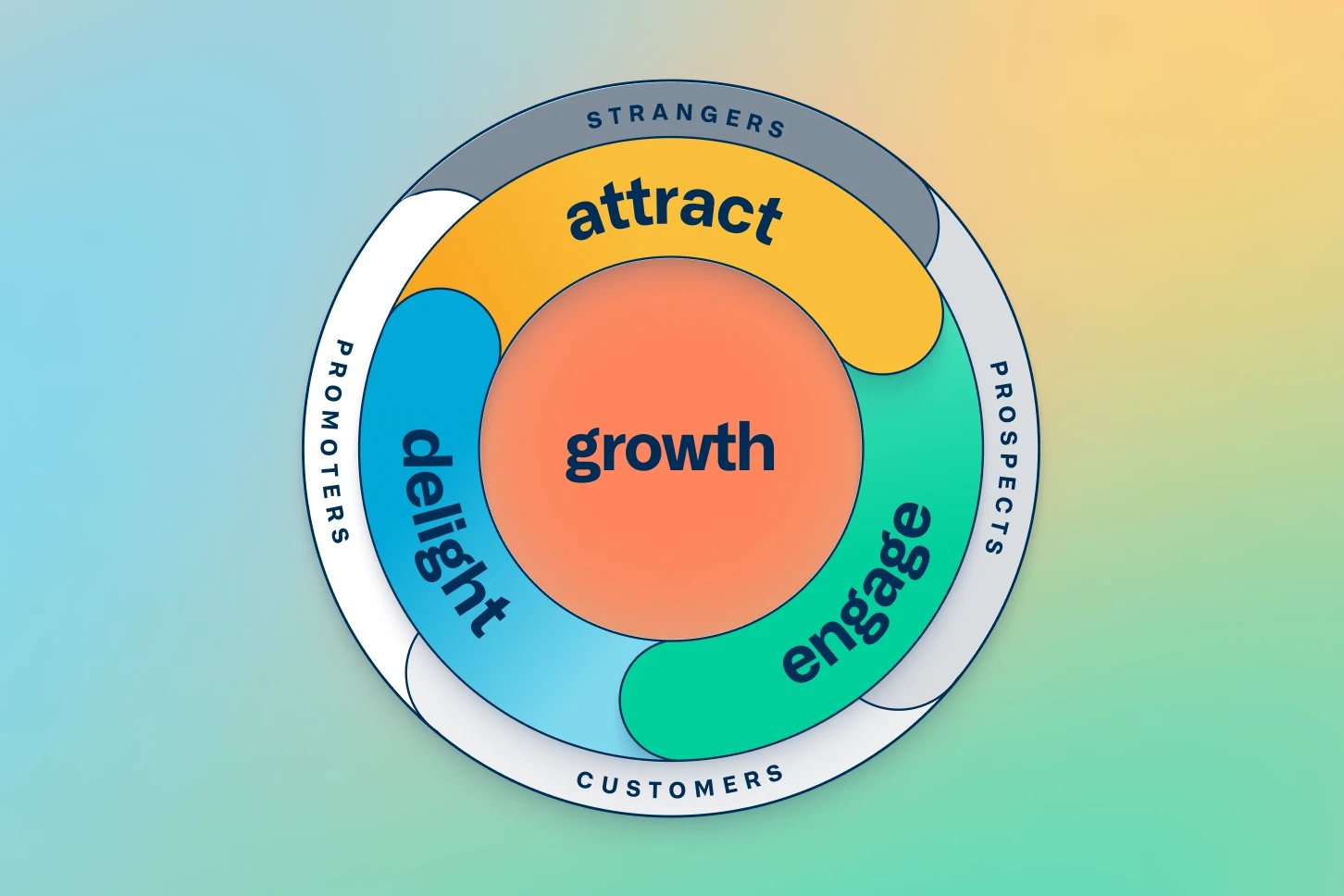
what is HubSpot?
HubSpot harmonizes your CRM, Sales, Marketing, and Service efforts in one user-friendly platform. With the addition of CMS Hub, you don’t need a developer or IT to understand the backend of your website, and it can be set up quickly and efficiently, so your team experiences little-to-no downtime.
The suite of tools has options at every price point, so HubSpot will grow with your small-to-medium-sized business. You can plug and play, choosing which platforms you want, and which you can do without.
Each “hub” feeds into one another, allowing you to see a bird’s eye view of all of your marketing and sales efforts, and use context to keep track of each prospect in their buyer’s journey.
Sounds great, right? It is—and you can take our word for it.
We know your sales and marketing teams have zero time as it is. So why spread your marketing efforts throughout numerous different platforms?
The more segmented everything is, the harder it is to get a clear picture of whether your efforts are making a dent—and redundancies will add hours to your day.
That’s why we use HubSpot, an all-in-one marketing platform that shaves hours off of our weeks. HubSpot allows you to focus on more important things—like your clients. (remember them?)
HubSpot CRM
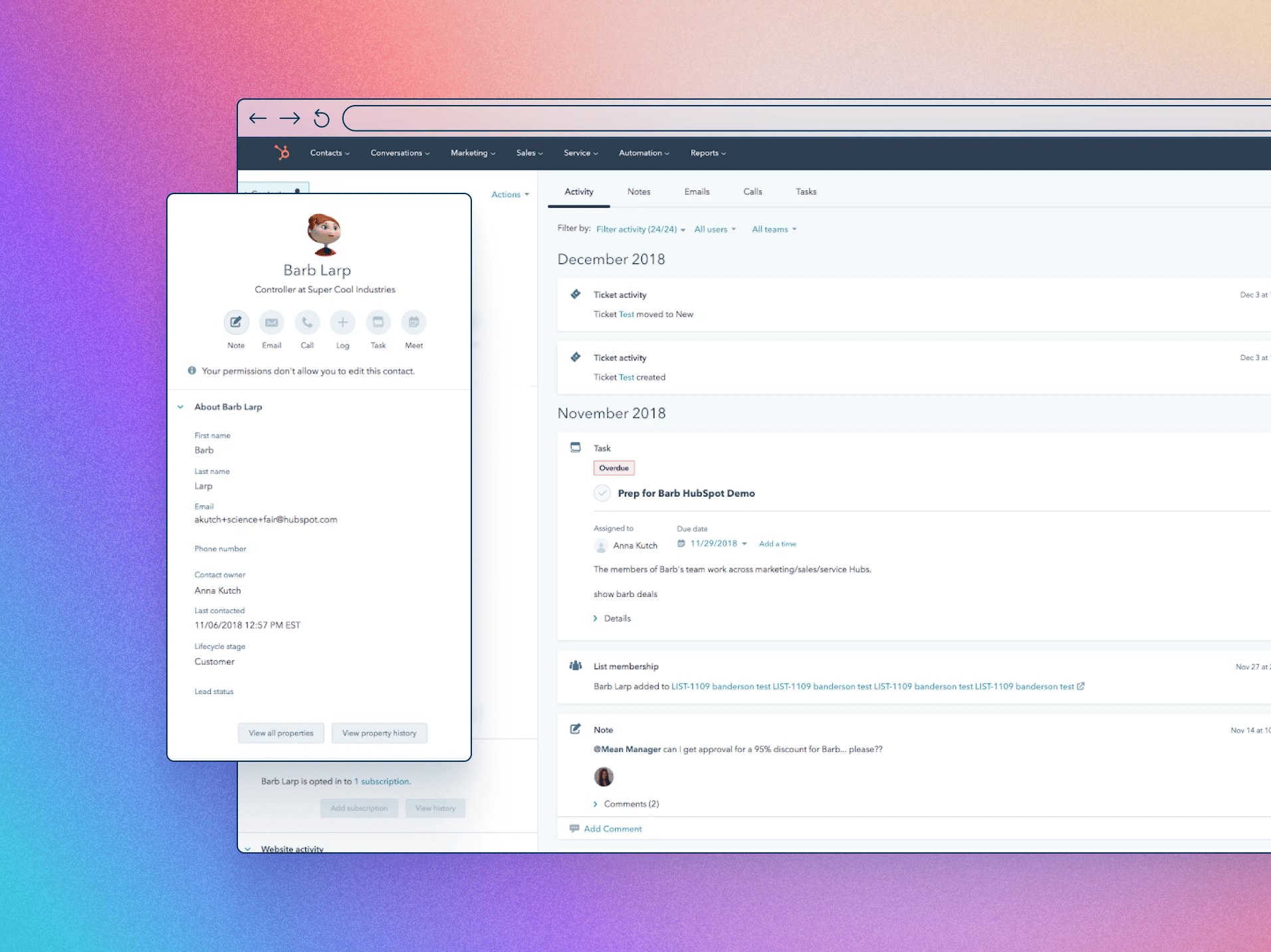
HubSpot’s CRM is easy to set up, and customizable to your unique sales process. You can customize your deal stages in less than an hour and configure it to your business preferences.
A lot of the marketing and sales process happens in your inbox. A few of our favorite features are email templates, tracking, and scheduling.
Templates turn a repetitive sales email into a saved template, so you all you have to do is personalize it, click send or schedule for the time of day when your prospect will be most likely to see it!
A lot of companies like their sales reps to work out of the CRM when sending a response to emails.
With HubSpot, you can track your email conversations within the CRM or in your preferred email provider, such as Gmail, Outlook, or Office 365. Log the information into the CRM with just a click of a button!
Although email is used frequently, everyone has a different way of looking for answers. One person may use email, another may use live chat and yet another uses social media.
Keep track of all of your conversations in one inbox, so you can read and reply to all of your messages in the same place.
And when you’re ready to meet with your prospect to further the conversation, skip the back-and-forth involved in setting up a meeting and send them a link from the Meetings tool. Your prospect can see your available dates and times and choose the one that works best for them.
When meeting over the phone, your CRM records and transcribes the call for you. It also tracks every touchpoint, so when you reach out to start the sales conversation, you know exactly what their conversion path has looked like.
This allows you to give each person the unique information they need to feel comfortable taking the next step in the buyer’s journey.
Throughout your sales process, set up tasks, so HubSpot can remind you at a date and time to send an email, or make a call to a prospect.
And when your prospect opens your email downloads an attachment or views your proposal, HubSpot’s real-time notifications will let you know, so you can follow up as soon as possible. Getting back to a prospect when you’re on their mind might be the action that closes a sale for your team.
marketing hub
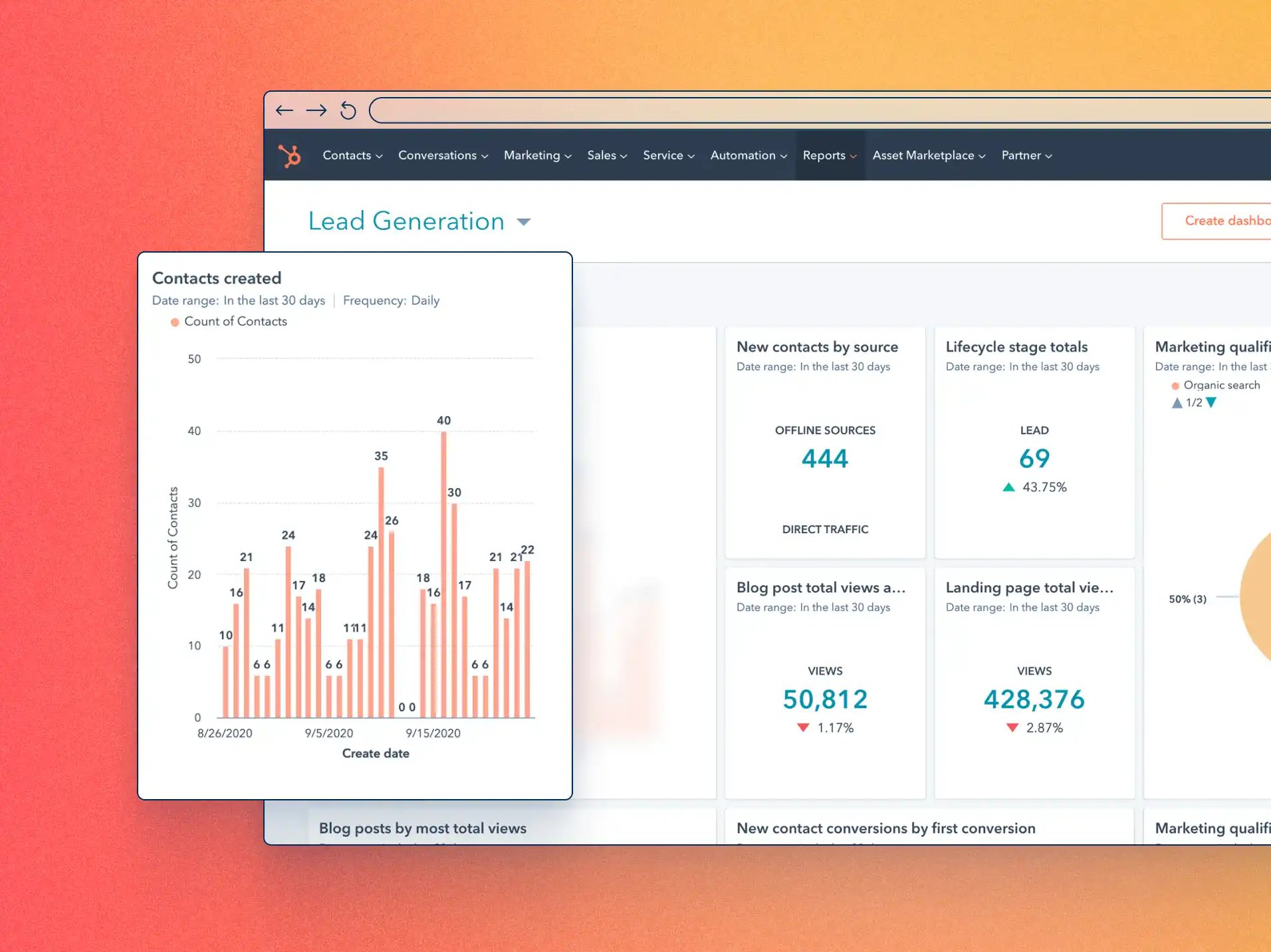
HubSpot’s Marketing Hub is a comprehensive suite of tools designed to attract visitors, convert them into leads, close deals, and delight customers.
The Marketing Hub connects with your HubSpot or Salesforce CRM to track the progress of leads, so your marketing and sales teams never miss a beat.
Your website is a 24/7 salesperson for your business, so it should be beautiful and functional, seamlessly guiding your visitor through the buyer’s journey—no pressure.
HubSpot CMS offers easy-to-use drag and drop features, so anyone can build a website. With HubSpot, you won’t need to write one line of code in your website build (unless you want to, of course).
attract
People actually have to find your website for it to do its job, though. If you’re focusing on organic search, this is where the SEO tool comes in.
You can publish web page after web page and blog after blog but if no one sees them, it’s wasted time and money.
The built-in SEO features will ensure you’re adding keywords, meta descriptions, inbound links, and more to up your SEO game, so you can get to page one and get results.
If your strategy also includes paid search, the Ads tool easily allows you to hook up your Facebook and Google Ads accounts to track performance and create audiences.
During the buyer’s journey, blogs can help answer questions and guide visitors to the next step.
According to HubSpot, 53% of marketers say blog content creation is their top inbound marketing priority—something so important should have the right tools to back it up.
With HubSpot’s blogging tool, you can create an inline blog or select draft mode to collect your thoughts in a distraction-free space. Optimize, schedule, and analyze the results of your posts, all in one robust blogging tool.
convert
Once a visitor finds your website, entice them with a call-to-action (CTA) to sign up for your email list, download an ebook, or participate in a live demo.
With the CTA tool, you're able to create a button or an image-based clickable object that you can put pretty much anywhere on your website—you can even put one in a video!
It also tracks the data on who clicked it, when they clicked it and where they clicked it, so you know what works and what doesn’t.
Once they’ve clicked the CTA, it’ll bring them to a landing page. Create your own landing pages by creating a form in the form tool and plugging it into one of HubSpot’s templates with content.
Hit publish and come back when you have results. Through the landing pages analytics, you can see who has converted, and HubSpot adds the new contacts to your CRM automatically.
Another way to grab a lead’s contact information is through a pop-up form.
Pop-up forms will leverage page visitation data, or completing a behavior threshold like time on page or scroll depth actions, and provide an opportunity to convert the user with an offer or value proposition.
The form is dynamically generated right there on-site, so the user does not have to leave the page to convert!
close
Once your visitor becomes a lead, you can use that information in many different ways to turn them into a customer.
Use the marketing automation feature to add them to a drip campaign. This will send them well-timed emails with information that will actually interest them.
Also, set up a workflow that assigns new contacts to their buyer persona, so you can tailor your marketing messages to their specific needs.
When your lead is this far into the buyer’s journey, they don’t want to see another CTA for that awareness-level ebook they read months ago.
Instead, use Smart content to show them a CTA they’ll actually convert on—maybe a free trial, perhaps?
delight
Just because you turned your lead into a customer doesn’t mean your work is done. Now is where the hard part begins—keeping them as a customer.
We’ve all heard that getting new customers costs a lot more than retaining old ones. But according to research by Fredrick Reichheld (creator of the net promoter score), increasing customer retention rates can also increase profits by 25% to 95%.
Use social media to delight your customers by answering questions and responding to concerns ASAP. Do this by monitoring your mentions and hashtags through the social media tool.
You can also schedule Facebook, Twitter, LinkedIn—and even Instagram posts, so you’re providing valuable content to your followers every day, no matter where they are in the buyer’s journey.
At every stage, you should be checking your progress. What works, what doesn’t work, what needs help… and HubSpot’s analytics tools give you the whole puzzle, not just a piece of it.
Access the analytics from inside each tool, or from the report drop-down menu to see views, click-through rates, bounce rates, session times, and a whole lot more.
The numbers tell you what you’re doing right and what you can do better to give visitors, leads, and customers the best experience possible.
sales hub
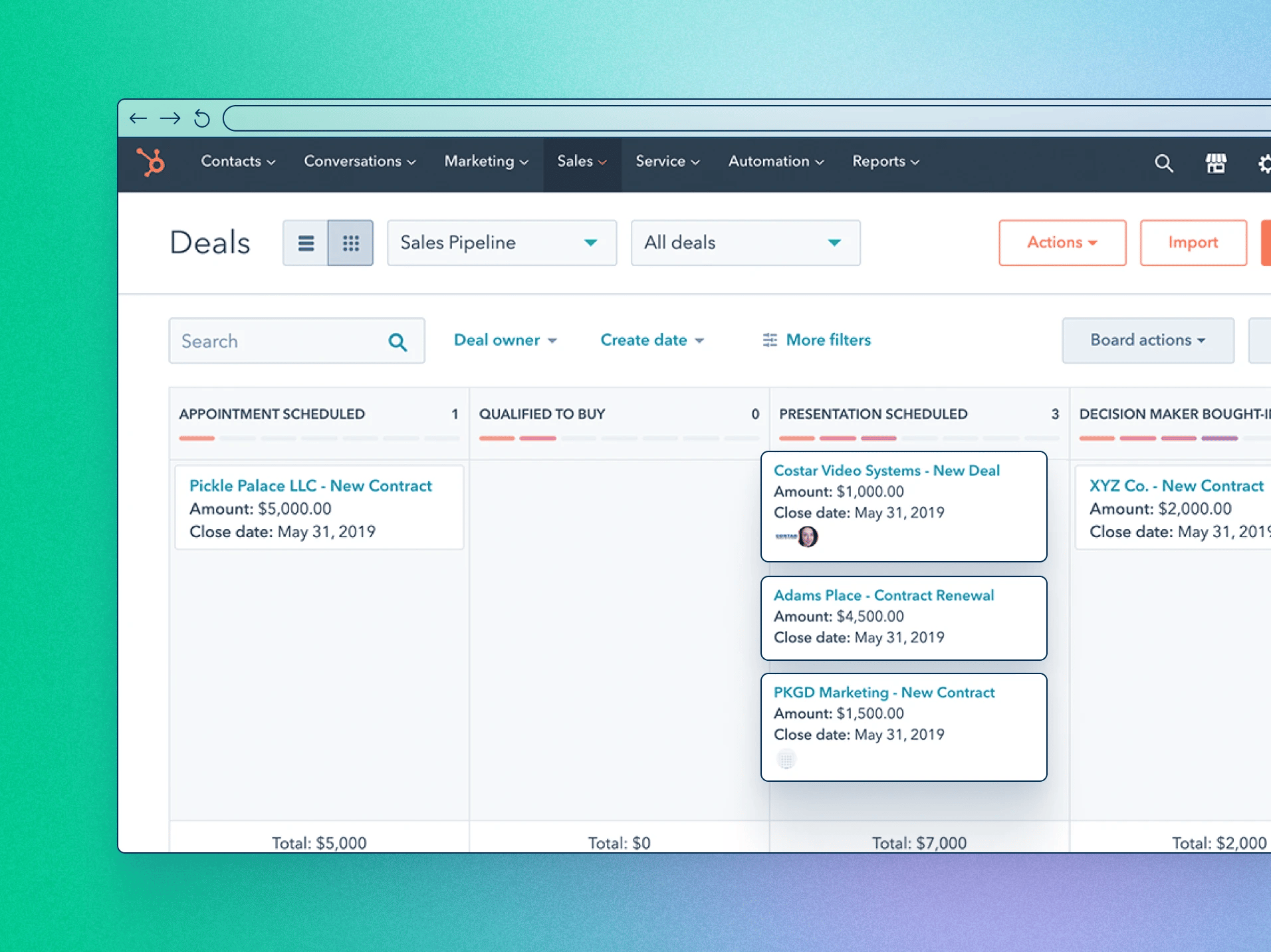
Toss those spreadsheets into the virtual garbage can. HubSpot’s Sales Hub software helps your team uncover more leads and turn them into customers faster.
The Sales Hub allows you to see your pipeline in an easy-to-manage interface, so no one slips through the cracks, and your prospects get all of their questions answered before making a purchase.
Once a lead is ready to talk to a salesperson, they’re usually halfway through the buyer’s journey—67%, according to a study by SiriusDecisions.
That’s where predictive lead scoring comes in. Understanding your leads and where they are in the journey is key to connecting to the right prospect at the right time.
With predictive lead scoring, HubSpot uses artificial intelligence to look at who’s converted on what, what pages of your website they’ve visited and more, and connects the dots to predict who has the highest likelihood of closing.
That way, you can focus on connecting with the warmest leads, and leave the colder ones to the marketing team.
Once you connect with a lead, add them to an email sequence. As salespeople, we know getting back to prospects is extremely important, but there are only so many hours in a day!
With email sequences, you can enroll prospects in a series of automated emails after speaking to them once, getting their information at a tradeshow or by another factor.
This way, you’re not spending hours sending the same email over and over again to different prospects or forgetting to send an email altogether.
These emails will usually include resources for the prospect such as case studies, pricing sheets, proposals, and other documents.
Instead of having to search for them, the Documents tool will hold all of your important resources in one place.
HubSpot also tracks who opened what and which documents lead to clicks, and eventually sales, so you can leverage your winners.
Once your prospect is ready to buy, use the Product and Quote tools to whip up a company-branded quote to send to them.
With the Product tool, add the products your company sells, and then add the products your prospects have interest in-in to the deal.
Once they’re ready for a quote, a click of a button will create a visually-appealing quote you can easily attach to an email.
service hub
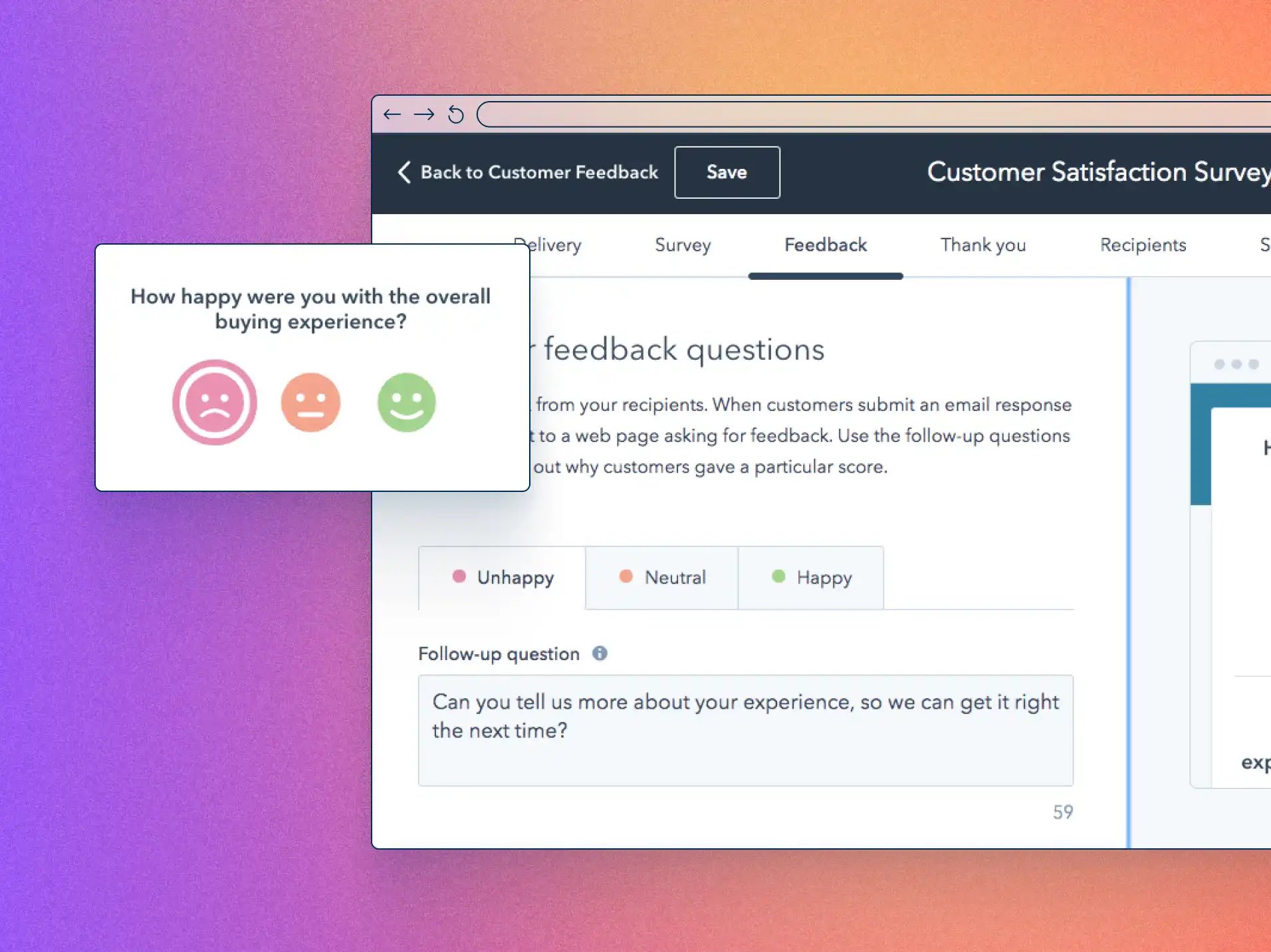
HubSpot’s newest product, Service Hub, allows you to provide your customers with top-notch customer service.
Customers have more power than ever before and giving them support when and where they need it will allow you to retain customers and turn them into promoters.
Connect with customers in the conversations inbox, which takes every incoming email, DM, and more, and keeps it in one easy-to-use inbox.
When you reply, your response goes right back to the medium they used. Live Chat is also connected, so when a customer asks a question through the chat window on your website, you can answer immediately.
When a customer contacts your team about an issue, create a ticket so you can route it to the best person for the job.
The ticket will record what the problem is, who it is assigned to, what the priority level is, and more.
Create tickets with automation, by setting up rules, or directly in a contact record.
Open and keep track of all of your tickets on the dashboard, so everyone’s questions get answered in a timely manner.
Avoid answering the same question over and over again. Next time you get a FAQ, turn the answer into an article in the Knowledge Base.
Optimize it for search engines or send it to a customer when they ask. That way, you’re spending less time on repetitive questions and they’re spending less time waiting for an answer.
Another way to help your customers get an answer ASAP is through a conversational bot.
Unlike live chat, there is no real-life person on the other end, but it can help a customer or lead find their way around your website, to a helpful article or salesperson.
When everything is said and done, you want to know how you did, right?
Use the feedback feature to send a survey to a customer you just helped, to a list of customers who had the same problem, or to just get a pulse check on your customers.
You can also use the reporting features to see customer feedback, ticket response time, knowledgebase usage and more to keep improving your customer service initiatives.
service hub starter
HubSpot has the simplest and easiest to use ticketing system for support teams with Service Hub Starter, add that to Marketing Hub and/or Sales Hub and you now have more visibility on the customer lifecycle than ever before, and it’s all in one place.
With Service Hub Starter you can build your own Customer Success help desk and scale it with your business. Offering customers the experience they want to have with your business is the best way to grow, Service Hub allows you to do this at scale.
Service Hub Starter features:
- Tickets
- Conversations, all in one inbox for customer support
- HubSpot Messages, live-chat software
- Email sequences
- Email and Chat support
service hub professional
Building your help desk solution for your business gets a serious leg up with Service Hub Professional.
Take your standard ticket system to the next level by taking action in greater scale.
With the Professional subscription, you’re able to dig deeper into CX data, respond quicker with knowledge center articles and videos, and create custom reports.
Service Hub Professional Features:
- Custom fields for support forms
- Customer service reporting
- Password-protected articles for Knowledge Base
- Knowledge Base feedback including, CX surveys
- Expanded customer insights reporting
- HubSpot Video
content hub
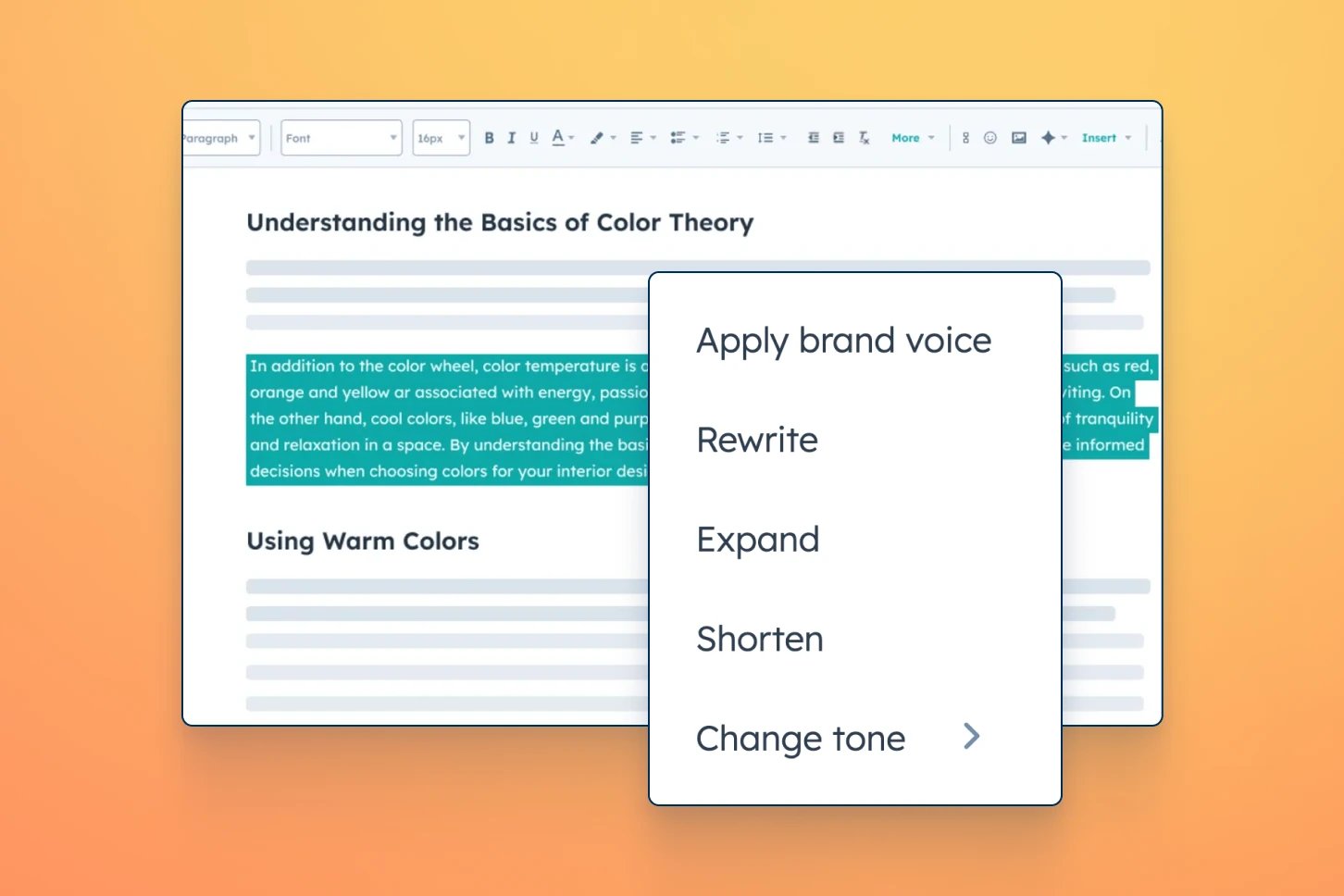
HubSpot's Content Hub is a powerhouse of content creation and management tools for today's marketers and business owners.
Poised at the intersection of technology and creativity, this robust platform offers a range of solutions designed to streamline and elevate your digital marketing strategy.
Leveraging HubSpot's Content Hub can transform your digital marketing efforts, making the process not just more efficient, but also more effective.
It simplifies content creation, management, and optimization across multiple channels, ensuring your message resonates with your audience precisely when and where it matters most.
With its intuitive design and sophisticated analytics, the Content Hub gives you a clear view of what content performs best, enabling you to tailor your strategy based on real data.
Additionally, it fosters collaboration among your team members, breaking down silos and encouraging a unified approach to content creation.
This not only helps in maintaining a consistent brand voice but also in maximizing the impact of your content marketing investments.
content hub professional
The Professional tier of HubSpot's Content Hub provides users with a suite of capable tools crafted to enhance and personalize the content experience.
With Content Remix, brands can repurpose existing content with ease, amplifying their message across different channels. The Brand Voice feature maintains your organization's distinct tone across all published materials, ensuring consistency.
Podcasting capabilities allow you to expand into audio content, engaging audiences in a dynamic way while fostering a deeper connection. Using Dynamic Personalization, content adjusts in real-time to the viewer, contributing to a more tailored user experience.
Every aspect of content from creation to optimization is supported with a robust suite of tools. Memberships and gated content capabilities open doors to exclusive experiences, enhancing lead capture efforts.
On the SEO and reporting front, Professional offers advanced tools for content optimization and analytics, helping you align your strategy with your audience's needs and measure performance accurately.
cms hub enterprise
For larger organizations with more complex needs, the Enterprise tier offers an expanded suite of features.
Everything included in the Professional tier is complemented by even more sophisticated tools.
Multisites facilitates the management of multiple web properties from a single platform, accommodating businesses with numerous brands or regional sites.
Content approvals, permissioning and teams, and activity logging features allow for streamlined workflows and better collaboration within larger teams, enforcing governance and keeping track of each change.
Incorporating custom objects, this tier also allows more flexibility and customization of databases, while serverless functions deal with various backend processes without the need for a dedicated infrastructure, reducing complexity and costs.
Whether you're a small company or a multinational corporation, HubSpot's Content Hub is ready to help you build a remarkable content experience that captivates your customers.
Using AI-powered generation and lead capture tools within a scalable CMS, video and podcast hosting, and comprehensive testing and SEO recommendations, it's easier than ever to develop a content strategy that drives traffic, leads, and conversions.
operations hub
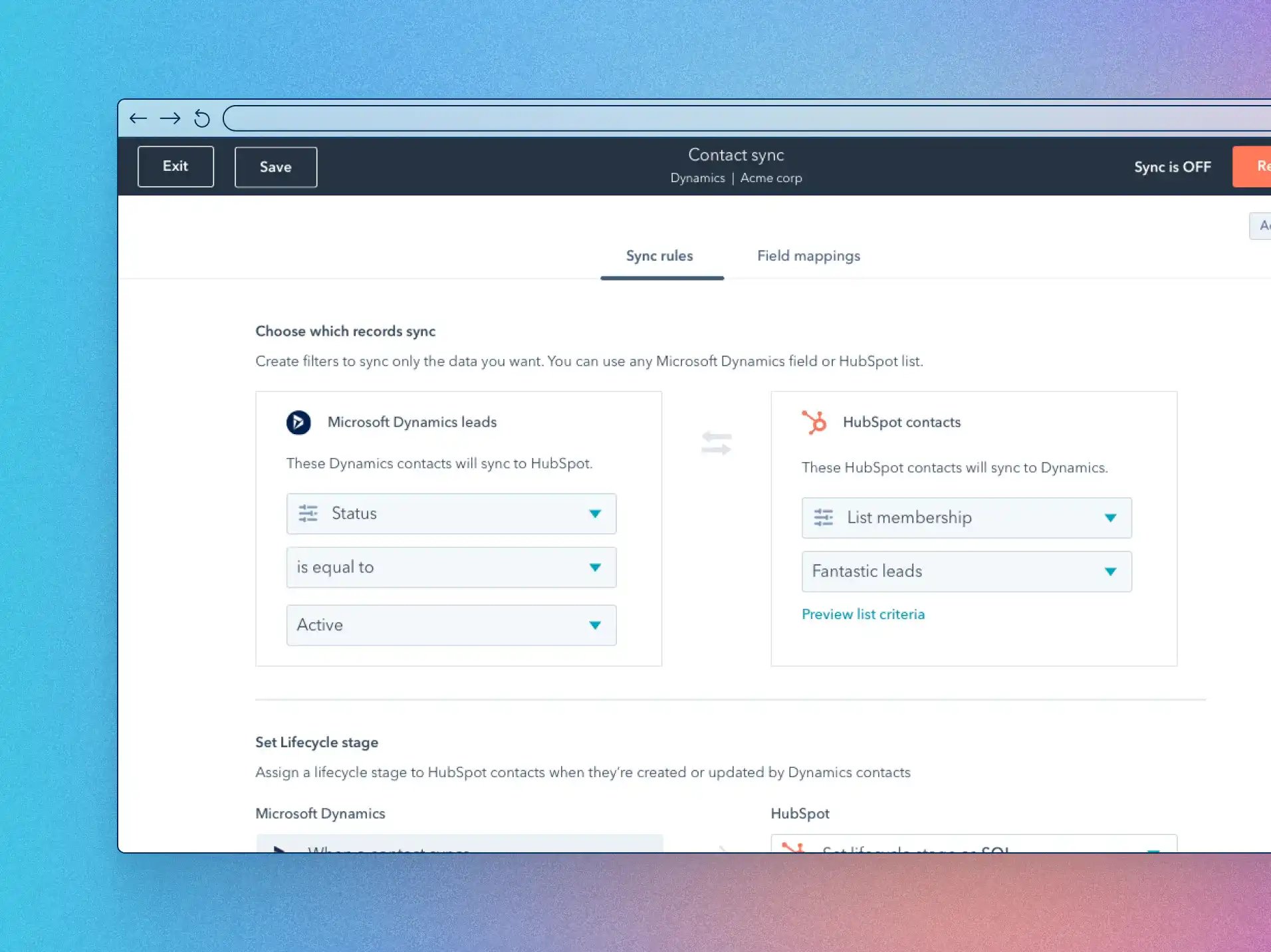
Operations Hub is a revolutionary tool that optimizes your operations, connects apps, cleans customer data, and automates business processes.
With Operations Hub, you can now integrate all your apps into one central system, allowing for seamless process flow and coordination.
Operations Hub has a built-in feature that cleanses your data, eliminating duplicate entries and ensuring accurate, up-to-date information. Say goodbye to manual, time-consuming tasks.
Operations Hub automates business processes, freeing up your team to focus on what really matters – growth and innovation.
data sync
Sync your apps and data effortlessly with our intuitive, no-code solution. Say goodbye to the hassle of manual syncing and embrace bidirectional sync, custom field mappings, filtering, and historical syncing.
With our comprehensive package, your teams can collaborate seamlessly and ensure alignment across all departments. Experience the power of effortless synchronization with Operations Hub.
data quality automation
Say goodbye to tedious data cleanup tasks with our game-changing solution. Wave goodbye to the hours spent manually fixing date properties, formatting names, and more.
Our new out-of-the-box automation feature automatically handles these time-consuming tasks, freeing up valuable time for you and your team.
Experience the efficiency of streamlined data management and let HubSpot take care of the details, so you can focus on what truly matters—driving your business forward.
custom-coded actions (workflows)
HubSpot's custom-coded workflows offer a powerful solution for businesses seeking to extend the functionality of their automation processes.
By leveraging custom code actions, users can create tailored workflow actions within and outside of HubSpot, allowing for greater flexibility and customization.
These custom-coded workflow actions enable businesses to define specific data outputs that can be utilized as inputs for various operations, enhancing the overall effectiveness of their workflows.
With the ability to automate complex processes and integrate with other systems seamlessly, HubSpot's custom-coded workflows empower teams to work more efficiently and achieve their business goals.
Discover the endless possibilities of custom-coded workflows and unlock a new level of automation prowess with HubSpot.
data quality command center (BETA)
Gain valuable insights into the health of your HubSpot data with ease. Consolidate all key information in one central location, providing you with at-a-glance visibility into the status of your data.
Identify stale properties, pinpoint integration bottlenecks, and more, empowering you to proactively address potential issues before they escalate. Sstaying on top of your data has never been easier. Stay ahead of the game and ensure the smooth operation of your business.
Like every other Hub, Operations Hub has a large slew of features and benefits spread across their four tiers—Free, Starter, Professional, and Enterprise.
enterprise CRM suite
It’s no secret that HubSpot was originally built to help small to medium-sized companies. However, post INBOUND 2018, we now know that HubSpot has built the capacity to meet the needs of the largest companies.
Enter the Growth Suite, a bundling of HubSpot’s three enterprise service offerings: Marketing Hub Enterprise, Sales Hub Enterprise, and Service Hub Enterprise.
A lot of the new updates for enterprise are focused on the logistics of larger and more sophisticated teams who use HubSpot.
There have been some massive improvements to Marketing Hub Enterprise and they’ve added two new product offerings: Service Hub Enterprise and Sales Hub Enterprise.
platform features
Each product offering has a unique configuration designed to meet the needs of companies and teams at each stage of growth and business maturity.
To create a tool that provides comprehensive of the inbound methodology through marketing, sales, and service many features are now shared across the products; Marketing Hub Enterprise, Sales Hub Enterprise, and Service Hub Enterprise.
These features are referred to as “platform features”.
Note to the reader: some features are available right now others will come out soon. All features discussed at the Enterprise level can be accessed in a bundle HubSpot is calling the Enterprise Growth Suite.
the enterprise system of record
HubSpot provides everyone on your team a single shared view of the contact and HubSpot Sales Enterprise has all of the team management features that larger and more sophisticated teams need to make HubSpot their system of record.
With features like hierarchical teams, enhanced permissions, and single sign-on HubSpot has built a tool that will match the way your company is structured.
You now have more control to make sure the complexity of your business does not get in the way of your team’s work.
For teams who do not have a traditional office or communicate with remote workers should consider the native Slack integration to better manage team communication!
Integrations are great however HubSpot has also built out tools to help you better manage content across languages, regions, and teams.
At the Enterprise level, things were messy! Now teams from different verticals, brands, or languages can be organized to work side-by-side in HubSpot and never get in each other’s way.
Let’s take a look at how HubSpot is going to help us get organizational with new features in the HubSpot Enterprise Growth Suite.
Content partitioning is a great feature because it allows you to finally segment your blog, landing pages, website pages, forms, and all content assets by teams within a company and therefore your portal.
For example, Team Europe never really has to worry about sorting through all of Team United States’ work to get to their own.
For teams concerned about different regulatory practices, like GDPR, across multiple countries, this is great! Content Partitioning has three aspects to consider.
what is content partitioning in HubSpot
Membership-based Content: Huge opportunity for companies that want a paywall for some content.
Now you can use HubSpot Lists to power access to certain parts of your site. You can restrict access to certain content from regular site visitors and serve up a premium experience on your site for paying members, internal company use, and other variations on Lists in HubSpot.
Enhanced User Types: Creating Users in HubSpot thus far has been pretty straightforward, you manage portal wide access to HubSpot apps.
Well, now you can group permissions, layouts, and views upon HubSpot by user type. This is a real enterprise feature for those working across the globe.
Hierarchical Teams: This is another layer of organization. You can manage your user types but now you can also group your HubSpot portal users on multiple tiers.
Now you can reflect in HubSpot the very way your team operates; organize users by teams, region, business unit, product line, or any other dimension.
HubSpot has also added new features to Enterprise that more closely aligns with the custom data that most big companies need to make decisions.
Custom Events and therefore Custom Properties are now searchable within the HubSpot search bar. Now Enterprise users will enjoy a more robust database that more accurately reflects their world of data.
sales hub enterprise
Get the flexibility you need to manage the most complex sales strategies with ease. Sales Hub Enterprises updates are all about advanced deal management and sales rep productivity.
Deals at the Enterprise level can be complex and pipelines need custom configuration. Keep track of recurring revenue, collect e-signatures on quotes and other documents, and seamlessly accept payments via our native integration with Stripe.
Create fields in HubSpot that perform useful calculations and roll up data from other fields, like sales commissions and splits. With more functionality, sales reps need to remain productive.
HubSpot Sales Hub Enterprise saves sales reps time with a bunch of exciting productivity and acceleration updates: e-signature, call transcription, and the anticipated playbooks feature.
Playbooks is a brand new feature that lets managers arm their team with call scripts, competitive battle cards, and more.
This means that you can use rules-based automation to surface the most valuable content to your sales team, right inside of HubSpot.
marketing hub enterprise
HubSpot started as a premier marketing solution for small to medium-sized businesses, now with Marketing Hub Enterprise, there’s an option for each stage of company growth.
Since the launch of Enterprise, a lot has trickled down to Starter and Pro editions of HubSpot Marketing.
new features now included with HubSpot Marketing Starter:
- Email marketing tools, including drag and drop email builder
- A suite of lead conversion tools
- HubSpot Conversations, including HubSpot Messages (live-chat)
- The top-rated CRM for small to medium-sized businesses
Get started there and as you grow HubSpot Marketing has an option for every tier.
Marketing Hub Enterprise gives the larger and more complex marketing teams the advanced features they need with the user-friendly experience that HubSpot has become well known for.
new features to HubSpot Marketing Enterprise:
- Analytics views
- Content partitioning
- CMS membership
- Facebook Messenger integration
- Continuous testing with machine learning
With Traffic Analytics in HubSpot, you can view sessions, contacts, and customers from every marketing channel.
With the new Analytics Views in Enterprise you can now break down your sources report with specific segments of traffic: country, domain, specific URL structure, and more.
So let’s say you’re hosting a blog at a specific subdomain, you could see how many sessions, contacts, and customers were driven there by a specific social media channel.
With Teams in Content Partitioning in HubSpot Enterprise, you’re able to group users together for reporting and permissions.
You’re also able to limit viewing, editing, and publishing to specific users and even teams.
This makes it possible for large teams, especially those working internationally or with various languages, to work side-by-side in a single instance of HubSpot.
CMS membership restricts content access to internal audiences like paying customers or other groups of contacts.
This is possible through HubSpot Lists and can be incredibly powerful for membership organizations, exclusive content, and customization.
Facebook Messenger is a powerful and new marketing channel that is getting amazing results.
With HubSpot, you can build a full conversion path that is native in Facebook messenger without the need for emails, landing pages, forms, or site content.
Pop-up forms (previously lead flows) is now powered with machine learning and artificial intelligence.
Set and forget HubSpot Pop-up forms while the algorithm sorts the best placement and version of your lead generation tactic.
HubSpot video
Massive update alert: the whole HubSpot platform is now powered with HubSpot Video. HubSpot has long championed the power of video to move the needle on a variety of success metrics for businesses.
However, production and resources have long held back the average company from achieving success with video.
Now, there's HubSpot Video. The whole point is to give businesses the confidence and the toolset to create shorter, more personal, more authentic videos—quicker and more efficiently than ever.
This empowers businesses to create the video strategy that will have the most impact, instead of investing in a few overproduced and toiled over video assets.
hubspot video features include:
- Simplified video creation
- Access to video assets in 1:1 communication tools
- Video Analytics and tracking
HubSpot's rationale for service and sales teams: it's so much easier to solve a customer's question and form a personalized relationship with that customer with video.
When it comes to marketing, now marketing teams have access to the video library management tools they've been waiting for.
Now you can easily keep organized, track your success, and power up your videos with interactive features. In-video CTA's and forms are now available.
Furthermore, video engagement metrics can power lists, workflows, and smart content. There is also, an entirely new video dashboard for video analytics.
the history of HubSpot
Brian Halligan and Dharmesh Shah, the founders of HubSpot, met while attending graduate school at MIT.
As Brian was helping venture-backed startups with their marketing strategies, he noticed that the tried-and-true marketing tactics (flyers, cold calls, email blasts) weren’t as effective anymore.
At the same time, Dharmesh’s blog, OnStartups, was gaining a ton of traffic with no budget.
So, after many discussions, Brian and Dharmesh came to the conclusion that people didn’t want to be harassed by a salesperson anymore. They wanted to be helped—through what they called "inbound marketing." And so, HubSpot was born.
the HubSpot ecosystem
HubSpot isn't only easy-to-use marketing and sales software. It’s also a community of people, an educational platform, and a marketplace that is there to help you and your business succeed.
Start honing sales and marketing skills through HubSpot Academy. Nineteen certifications including Inbound Marketing, Inbound Sales, and Social Media will allow you to grow in your inbound knowledge and apply it to your business.
And—unlike your college education—they’re all free! While you’re on the website, peruse the free marketing resources HubSpot has to further your education.
From guides to templates, to webinars and more, the resources can give you ideas for your own business and educate your team on marketing best practices.
And when you’re ready to start building a website and other assets (emails, landing pages, modules), you can find templates in HubSpot Marketplace.
HubSpot is fully aware that they aren’t the end-all, be-all software solution to marketing and sales. That’s why they’ve partnered with software companies that want to integrate their software with HubSpot’s.
HubSpot App Partners must meet the criteria to be considered for the partnership, like sharing customers and abiding by inbound marketing and sales principles.
Through the App Partner Program, you can see analytics from every stage of the cycle, right in your HubSpot dashboard. Some notable HubSpot App Partners are Slack, Salesforce, Zoom, Wistia, and Eventbrite.
If you don’t know where to start with HubSpot, or you’d like to see better results with your inbound marketing and sales, that’s where a partner agency can come in.
media junction and agencies around the world have partnered with HubSpot to better serve their customers and grow their businesses. A HubSpot Partner Agency can help with your brand and social media management, website design, content creation, and more.
There are five tiers, based on the success of each partner: Elite, Diamond, Platinum, Gold, and Silver.
Deciding whether you should partner with an agency can be difficult. You can do everything alone, but do you really want to? Partnering with an agency that knows HubSpot inside and out—even for just six months—can set you up for success in the long run.
Choosing between agencies is hard, as well. Finding an agency that fits your goals and culture is important, and with over 2,500 partner agencies, there’s definitely one out there that will fit your business.
You can also lean on the HubSpot Community for questions about anything HubSpot-related. Post to the forum or find the answer from a past question. You can also post to the HubSpot Ideas forum to tell HubSpot what you’d like to see!
Gather with other HubSpot partners, agencies, and enthusiasts for the annual INBOUND conference in Boston.
INBOUND attracts tens of thousands of marketers, salespeople, and innovators from across the globe each year to hear speakers and connect with other HubSpotters. Speakers have included Michelle Obama, Rand Fishkin, Shonda Rhimes, and more.



